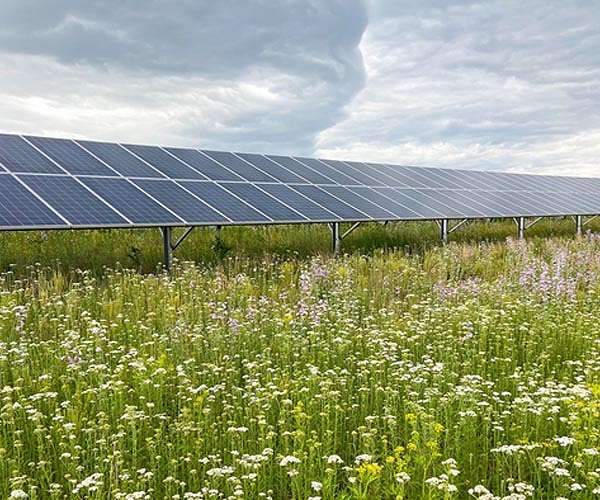MIT, Harvard and Mass General lead 408 MW green energy push
MIT is co-leading an effort to enable the development of two new large-scale renewable energy projects in regions with carbon-intensive electricity grids: Big Elm Solar in Bell County, Texas, which came online this year, and the Bowman Wind Project in Bowman. County, North Dakota, is expected to be operational in 2026. Together they will add a total of 408 megawatts (MW) of new sustainable energy capacity to the electricity grid. This work is a critical part of MIT’s strategy to reach its goal of net-zero carbon emissions by 2026.
The Consortium for Climate Solutions, which includes MIT and 10 other Massachusetts organizations, aims to eliminate nearly 1 million metric tons of greenhouse gases each year—more than five times the annual direct emissions of the MIT campus—by committing to estimated to purchase 1.3 tons of greenhouse gases. million megawatt hours of new electricity generation from solar and wind energy per year.
“MIT has mobilized on multiple fronts to accelerate solutions to climate change,” said Glen Shor, executive vice president and treasurer. “Catalyzing these large-scale renewable projects is an important part of our comprehensive efforts to reduce carbon emissions from energy generation. We are pleased to work with other local companies and organizations to leverage the impact we can achieve individually to increase.”
The two new projects complement MIT’s existing 25-year power purchase agreement signed with Summit Farms in 2016, which allowed for the construction of an approximately 650-acre, 60 MW solar farm on farmland in North Carolina, leading to the early retirement of a coal-fired power plant. fired factory nearby. Its success has inspired other institutions to implement similar aggregation models.
A collective approach to enable global impact
MIT, Harvard University and Mass General Brigham formed the consortium in 2020 to provide a structure to accelerate global emissions reductions through the development of large-scale renewable energy projects – accelerating the impact of each institution’s greenhouse gas reduction initiatives and enlarged. As anchor points of the project, they jointly obtained the largest volume of energy through the aggregation.
The consortium entered into a partnership with PowerOptions, a non-profit energy purchasing consortium, which offered its members the opportunity to participate in the projects. The City of Cambridge, Beth Israel Lahey, Boston Children’s Hospital, Dana-Farber Cancer Institute, Tufts University, the Mass Convention Center Authority, the Museum of Fine Arts and GBH later joined the consortium through PowerOptions.
The consortium has tested more than 125 potential projects against the strict project evaluation criteria. With input from faculty and MIT stakeholders to shortlist the highest-ranked projects, Bowman Wind and Big Elm Solar were ultimately chosen. Together, these two projects will achieve major reductions in greenhouse gas emissions in two of the most carbon-intensive power grid regions in the United States and create clean energy generation sources to reduce negative health impacts.
“By enabling these projects in regions where grids are the most carbon-intensive, they can have the greatest impact. We expect these projects to prevent twice as many emissions per unit of electricity generated as a project of comparable size in New England,” he explains. Vice President for Campus Services and Stewardship Joe Higgins.
With all consortium institutions making significant financial commitments for the 15 to 20 year period to purchase electricity, the developer was able to obtain crucial external project financing to build the projects. The projects, owned and operated by Apex Clean Energy, will add new renewable electricity to the grid, equivalent to the power of 130,000 households per year, displacing more than 950,000 tonnes of greenhouse gas emissions annually from highly carbon-intensive power plants in the region.
Additional decarbonization is underway
In addition to investing in external renewable energy projects, many consortium members have developed strategies to reduce and eliminate their own direct emissions. At MIT, achieving this will require a transformative change in the way energy is generated, distributed and used on campus. Ongoing efforts include installing solar panels on campus roofs, which will quadruple renewable energy generation by 2026; continue the transition of our heat distribution infrastructure from steam-based to hot water-based; using design and construction that minimizes emissions and increases energy efficiency; the use of AI-enabled sensors to optimize temperature setpoints and reduce energy consumption in buildings; and converting MIT’s fleet to all-electric vehicles and adding more electric car charging stations.
The Institute has also upgraded the Central Utilities Plant, which uses advanced cogeneration technology to produce power that is up to 20 percent less carbon intensive than that of the regional electricity grid. MIT is charting a course toward a next-generation district energy system, with a comprehensive planning initiative to revolutionize campus energy infrastructure. The effort explores leading technologies including industrial-scale heat pumps, geothermal exchange, microreactors, bio-based fuels and green hydrogen derived from renewable sources as solutions to fully decarbonize campus operations by 2050.
“At MIT, we are focused on decarbonizing our own campus and the role we can play in solving climate on the largest scale, including supporting a cleaner grid in line with the call to phase out renewables worldwide to triple by 2030. Through these large-scale sustainable projects, we can have an immediate and significant impact on reducing emissions through the urgently needed decarbonization of regional power grids,” said Julie Newman, MIT’s director of sustainability.


